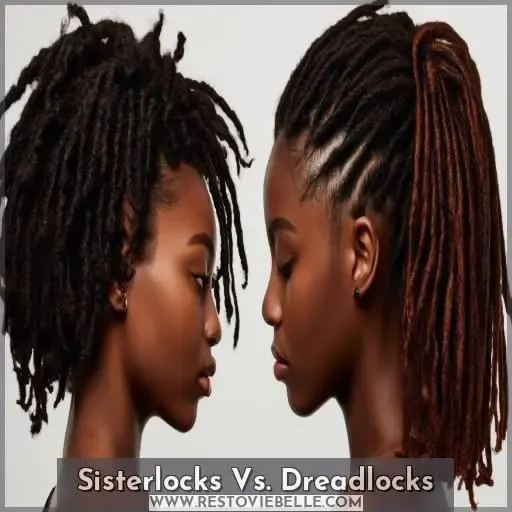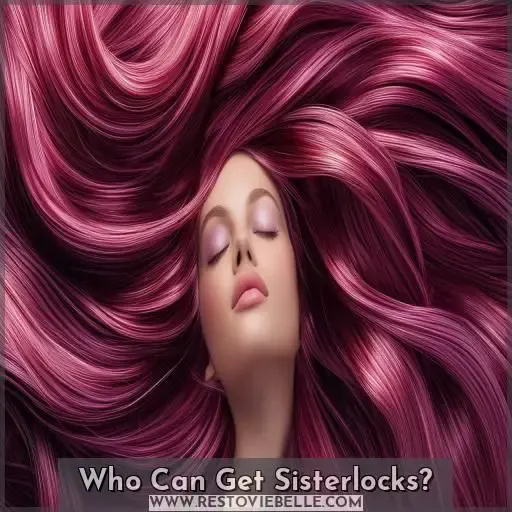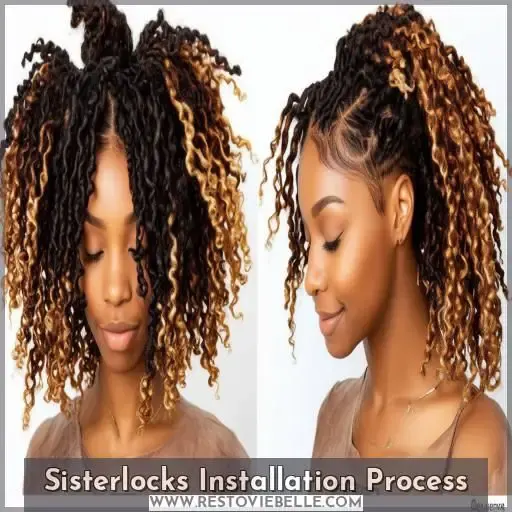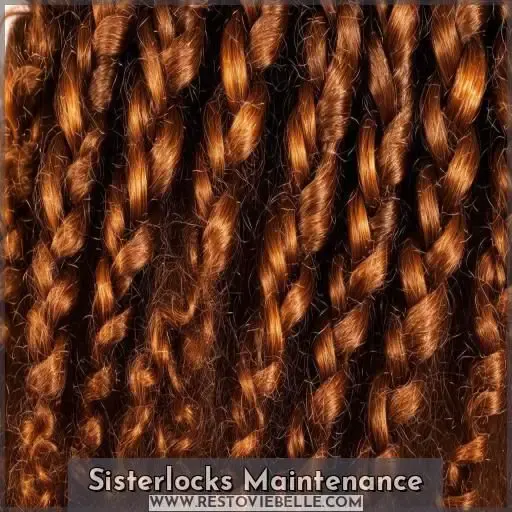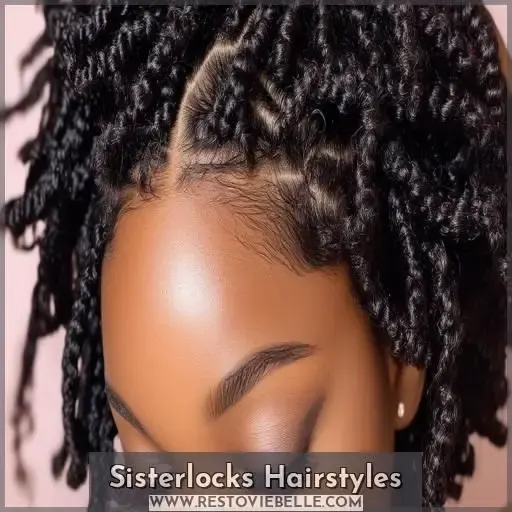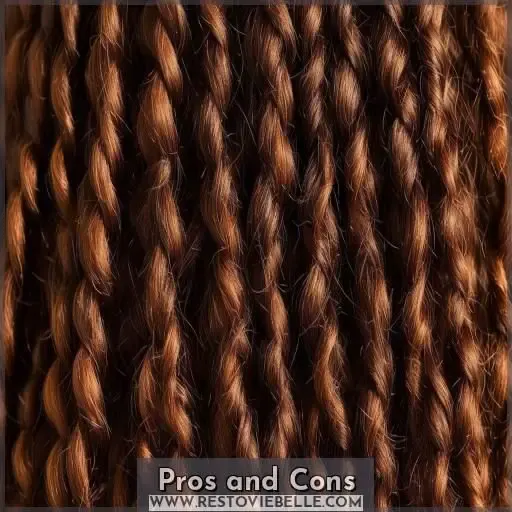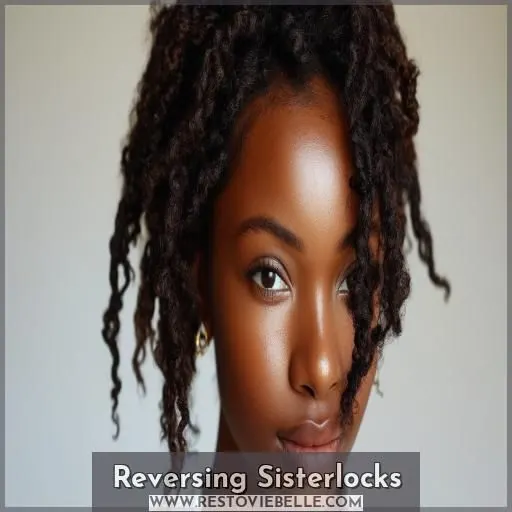This site is supported by our readers. We may earn a commission, at no cost to you, if you purchase through links.
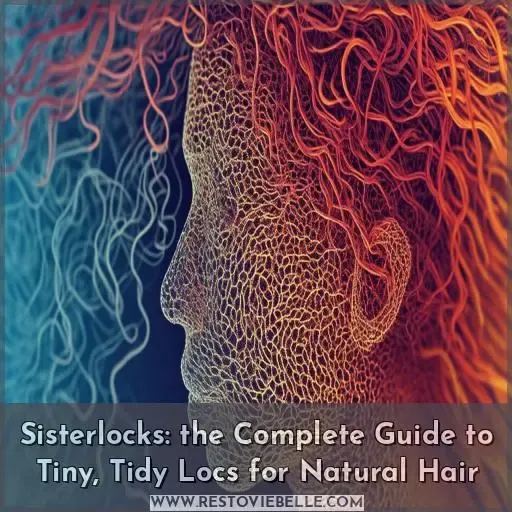 Sisterlocks are tiny, uniform locs created using a patented interlocking technique. You’re probably wondering what makes them so special.
Sisterlocks are tiny, uniform locs created using a patented interlocking technique. You’re probably wondering what makes them so special.
Well, these miniature dreadlocks are designed to minimize tension and breakage, allowing your natural hair to thrive. Unlike traditional dreadlocks, Sisterlocks use an interlocking tool to achieve their perfectly cylindrical shape and uniform size.
But there’s more to unpack – this low-maintenance style is suitable for all hair types and versatile enough for updos, ponytails, and beyond.
If you’re intrigued, keep reading to discover the ins and outs of this game-changing style.
Table Of Contents
- Key Takeaways
- What Are Sisterlocks?
- History and Origins
- Sisterlocks Vs. Dreadlocks
- Who Can Get Sisterlocks?
- Sisterlocks Installation Process
- Sisterlocks Maintenance
- Sisterlocks Hairstyles
- Pros and Cons
- Cost and Pricing
- Reversing Sisterlocks
- Frequently Asked Questions (FAQs)
- What is the purpose of Sisterlocks?
- How long do Sisterlocks last?
- Are Sisterlocks permanent?
- Can Sisterlocks be undone?
- How long do Sisterlocks typically last?
- Are Sisterlocks suitable for swimming and workouts?
- Can Sisterlocks be colored or highlighted?
- How often should Sisterlocks be retightened?
- Whats the best way to sleep with Sisterlocks?
- Conclusion
Key Takeaways
- Sisterlocks are tiny, meticulously crafted locs achieved through a patented interlocking technique – imagine having a head full of perfectly uniform miniature dreadlocks that move with elegance and grace.
- Unlike traditional dreadlocks, Sisterlocks are installed from the ends up, minimizing tension and breakage on your precious tresses. It’s like giving your hair a gentle, nurturing embrace.
- These low-maintenance beauties suit all hair types and textures, from curly to coily and even relaxed hair. They’re the versatile hairstyle that celebrates your natural glory, no matter your texture.
- While the initial installation is an investment of time and money, think of Sisterlocks as a long-term commitment to fabulousness. With proper care and maintenance, these tiny locs will have you turning heads for years to come.
What Are Sisterlocks?
Sisterlocks are your ticket to taming your natural tresses in a low-maintenance, protective style. These miniature-sized dreadlocks are created using a patented interlocking method, forming tiny, tidy locs from root to tip.
Unlike traditional dreadlocks, Sisterlocks installation starts at the ends of your hair, reducing tension and breakage. With their flat, weightless texture, these petite locs offer versatility – you can rock them in updos, ponytails, or free-flowing styles.
Suitable for all hair types and textures, Sisterlocks allow you to experiment with color while shielding your strands. Though the installation process is an investment in both time and money, these locs deliver long-lasting results, needing only periodic retightening every 4-8 weeks.
Embrace the freedom of Sisterlocks – a chic, low-maintenance ‘do that celebrates your natural beauty.
History and Origins
While we discussed what Sisterlocks are, you’re probably wondering – where did this ingenious hairstyle originate?
Let me take you back to 1993 when Dr. JoAnne Cornwell, a microbiologist and natural hair enthusiast, created Sisterlocks as an alternative to damaging chemical treatments and heavy extensions.
Revolutionizing the natural hair movement, Dr. Cornwell patented her specialized interlocking technique, designed to minimize tension and breakage while maintaining hair integrity.
Unlike traditional dreadlocks formed through palm-rolling, Sisterlocks utilizes a unique tool to interlock microscopic hair strands from the ends upwards.
This patented process, combined with a certified installation by trained associates, has kept Sisterlocks a popular protective style over two decades later for those seeking low-maintenance, versatile natural looks regardless of hair type or texture.
Sisterlocks Vs. Dreadlocks
Sisterlocks and dreadlocks are both protective hairstyles, but they differ in their installation process and overall appearance. While traditional dreadlocks require coiling, twisting, or palm-rolling techniques, Sisterlocks are installed with great care using a patented interlocking tool, creating tiny locs that are much smaller and more uniform in size than their dreadlock counterparts.
Installation Process
Unlike dreadlocks that require rolling or twisting, Sisterlocks are installed using a patented interlocking technique and specialized tool. Certified associates carefully section and interlock small hair portions from ends to roots over multiple installation sessions. This intricate process minimizes stress and guarantees uniform, consistent Sisterlocks.
Size and Appearance
Your Sisterlocks are the epitome of tiny tidy locs – way smaller than traditional dreadlocks. These micro braids resemble miniature locs, ranging from one-eighth to three-eighths inches wide. Their compact size creates an intricate, unique appearance while allowing experimentation with vibrant hair colors.
Maintenance Requirements
Compared to dreadlocks, Sisterlocks require more maintenance:
- Regular retightening every 4-8 weeks
- Specific hair products for scalp health
- Time-consuming styling and upkeep
- Higher ongoing costs
- Extra care needed to prevent breakage
However, this regular maintenance allows for versatility, controlled hair growth, and a tidy, polished look.
Who Can Get Sisterlocks?
You’re an ideal candidate for Sisterlocks if you have naturally curly or coiled hair textures, including relaxed hair. However, if your hair is severely damaged, it’s best to allow it to regain health before considering Sisterlocks to guarantee the best results.
Hair Types
Sisterlocks are designed for all hair textures – curly, coiled, or even relaxed. Your hair type doesn’t matter; these tiny locs embrace your natural beauty. They work wonders on low-density hair, adding gorgeous volume. If you’re rocking short tresses, no problem! Extensions allow Sisterlocks for those desiring more length. Embrace your power through this versatile, liberating style.
Hair Conditions
Along with considering your hair type, it’s essential to evaluate the health of your hair before getting Sisterlocks.
If you’re experiencing significant damage, breakage, or thinning, it’s wise to allow your hair to recover before installing this style.
Sisterlocks are a commitment, so making sure your hair is strong enough for the process is important.
Sisterlocks Installation Process
The Sisterlocks installation process begins with a consultation, where you’ll discuss your desired look and a specialist will determine the appropriate pattern by first installing 5-10 Sisterlocks. Once the pattern is set, the full installation takes place over 15-24 hours as the specialist interlocks small sections of your hair from the ends to the roots using a specialized tool.
Consultation
The Sisterlocks journey begins with a consultation. Your consultant will assess your hair’s suitability, discuss your expectations, and explain the commitment. Follow any pre-consultation care instructions, and come prepared with questions—this tiny hairstyle requires significant time and financial investment.
Pattern Determination
After the initial consultation, your stylist will install 5-10 Sisterlocks to determine the best pattern for your hair texture and desired appearance. This critical planning phase makes sure your Sisterlocks complement your facial features and support long-term hair growth goals. With the right pattern designed to your needs, you’ll achieve beautiful, neat micro braids that reveal your natural beauty.
Full Installation
After finding the perfect sisterlock pattern, it’s time for the full installation! Your stylist will expertly interlock tiny sections of hair, creating beautifully-uniform locs using their specialized tool. With various patterns and customization options, you’ll achieve a natural, yet mastered look crafted to your unique hair texture and density.
Sisterlocks Maintenance
To maintain your Sisterlocks, you’ll need to stick to a consistent retightening schedule, typically every 4-6 weeks. Proper washing and drying techniques are also essential – use a Sisterlocks-approved shampoo and allow your locs to air dry completely to avoid moisture buildup.
Retightening Schedule
You’ll need to retighten your Sisterlocks every 4-8 weeks. This retightening schedule guarantees:
- Your locks remain tidy and frizz-free
- The roots stay flat and smooth
- New growth is interlocked properly
- Your style maintains its polished look
Retightening appointments are essential for keeping your Sisterlocks fresh and fabulous.
[OUTLINE FOR ‘Retightening Schedule’ SUBTOPIC]:
- Recommended frequency: Every 4-8 weeks
- Process takes 2-4 hours on average
- Performed by certified Sisterlocks consultants
- Specialized interlocking tool is used
Now the real question – how much will this lock-tight commitment cost you? Retightening prices can vary, but typically fall in the $50-$150 range depending on your area. A small price to pay for:
- Preserving your edgy Sisterlocks ‘do
- Radiating confidence in your unique style
-
Mastering a bold, liberating hairstyle
Some quick tips before your next retightening session:
- Avoid shampooing 1-2 days prior
- Arrive with dry, product-free hair
- Be ready for some tightness (ibuprofen helps)
-
Embrace the process as self-care
Retightening keeps your locs looking fresh while allowing your inner fierce to shine through. It’s an investment in turning heads and owning your fabulousness.
Washing and Drying
You’ll want to wash your Sisterlocks with a sulfate-free shampoo every 1-2 weeks. Be gentle when cleansing, and let your locs air dry completely before styling. Deep conditioning treatments every 4-6 weeks will keep your hair hydrated and healthy. Proper scalp care is key – make sure to massage your scalp regularly during washes.
Product Usage
You’ll need to be mindful about the products you use with your Sisterlocks. Opt for gentle, sulfate-free shampoos and lightweight conditioners that won’t build up or cause flaking. Avoid heavy butters, greases, and oils that can weigh down your locs. Joanne Cornwell has her own approved line, or consult your consultant for recommendations specific to your hair’s needs.
Sisterlocks Hairstyles
With Sisterlocks, you can achieve versatile styles from updos to ponytails, bobs to buns. These low-maintenance, natural hairstyles allow you to experiment with different looks while keeping your Sisterlocks healthy and protected.
Updos
Looking to switch up your Sisterlocks style? Try an updo! Sisterlocks allow for versatile updos using accessories like hair clips and jewelry. From a chic top knot to an elegant twisted bun, updos keep your locks secure while showcasing your gorgeous face. Just remember to use Sisterlock-approved products for healthy locks!
Ponytails
If updos aren’t your style, try rocking a sisterlock ponytail:
- Half-up sisterlock ponytail: Part your locks in half, securing the top half in a stylish pony
- High sisterlock ponytail: Pull all your locks up into a sky-high, eye-catching pony
- Low sisterlock ponytail: Relaxed yet chic, ideal for errands or brunch dates
- High sisterlock ponytail with head scarf: Wrap a vibrant printed scarf around your pony for extra flair
- Playful side ponytail: Sweep your locks to one side for an asymmetric, fun look
Bobs and Buns
For a short, edgy look, try the sisterlock bob! These versatile locs can be easily maintained at chin or shoulder length. Or go for the polished sisterlock low bun – it’s a chic, clean-cut style perfect for the office or a night out. With medium-length locs, you’ll have endless styling options at your fingertips.
Pros and Cons
You’ll want to weigh the advantages and disadvantages before committing to Sisterlocks. On the positive side, they offer low maintenance, versatile styling options, and suitability for various hair types and textures. However, the negatives include the high initial cost, time-consuming installation and retightening appointments, and potential for hair breakage if not properly cared for.
Advantages
You’ll love the versatility of Sisterlocks! This protective style allows for endless hair experimentation without damage. Customize your tiny locs to suit your natural texture and achieve any look you desire. Say goodbye to restrictive styles – Sisterlocks move freely and reduce breakage. With proper care, your hair will thrive under this low-manipulation technique. Liberate yourself with Sisterlocks!
Disadvantages
You’ll encounter a few cons with Sisterlocks:
- High Cost: Professional installation and regular retightening can be pricey, ranging from $450 to $2,500.
- Limited Styling Options: While versatile, you’re restricted in hairstyles compared to loose hair.
- Time-Consuming: The intricate interlocking installation process takes 15-24 hours initially.
However, for many, the convenience, protection, and low maintenance of Sisterlocks outweigh the drawbacks. It’s a personal choice based on your priorities.
Cost and Pricing
The initial installation of Sisterlocks can be a significant investment, with costs ranging from $450 to $2,500 depending on factors like your location and the experience of the certified consultant. Beyond the upfront expense, you’ll need to factor in maintenance costs for retightening sessions every 4-6 weeks to keep your Sisterlocks looking their best.
Initial Installation
With a process requiring certified professionals and specialized tools, the initial installation of Sisterlocks carries a significant cost. However, the customization possibilities and prevention of breakage make it worthwhile. You’ll consult with an expert to determine the ideal pattern for your hair type and density. Managing breakage and establishing a routine from the outset guarantees long-lasting, tidy locs.
Maintenance Costs
You’ll need to budget for regular maintenance of your sisterlocks. Retightening sessions at the salon every 4-6 weeks can cost $60-$200, depending on the stylist and length of your locks.
DIY methods at home can cut costs but risk hair damage if not done properly.
Consider customization options like color or accessories to refresh your look between retightenings. Embrace the journey of mastering this liberating style.
Reversing Sisterlocks
If you’ve had Sisterlocks for less than six months, reversing the style is fairly straightforward – the Sisterlocks will simply unravel during this initial period. However, if it’s been more than six months, the reversal process becomes more tedious as the roots will have tightened, requiring professional help to carefully and thoroughly undo each individual Sisterlocks.
Within Six Months
If you decide to remove your Sisterlocks within the first six months, the process is relatively straightforward. You’ll want to:
- Consult a professional to avoid damaging your hair
- Expect some shedding and breakage as the locs unravel
- Allow 4-6 weeks for your hair to fully detangle
- Be patient as your natural texture re-emerges
With proper care and a skilled Sisterlocks technician, you can regain styling versatility without major setbacks to your hair’s health or length.
After Six Months
If you’ve had your Sisterlocks for over six months, uninstallation becomes trickier. The locs are now an integral part of your hair, making the process time-consuming and costly.
Your consultant will carefully undo each lock, but expect some hair loss and styling challenges as your natural texture re-emerges.
Be prepared for a transitional phase as you regain control over your hair’s look and feel.
Frequently Asked Questions (FAQs)
What is the purpose of Sisterlocks?
Sisterlocks’ sole purpose: provide protective, personal pomp – powerfully perfecting your passion for fabulous, frizz-free freedom.
How long do Sisterlocks last?
Sisterlocks are long-lasting! With proper maintenance, you can rock them for years. Expect retightening every 4-6 weeks to keep those tiny locs fresh and fabulous.
Are Sisterlocks permanent?
No, Sisterlocks aren’t permanent – but they can last for years with proper maintenance. You’ll need retightening every 4-8 weeks to keep them looking fresh. If you decide to discontinue, the disentangling process is tedious but possible.
Can Sisterlocks be undone?
Yes, Sisterlocks can be undone, but it’s tedious after six months. If you desire a styling change, consult a Sisterlock professional before attempting removal yourself – improper techniques could damage your hair.
How long do Sisterlocks typically last?
With proper maintenance, Sisterlocks can last for years. You’ll need retightening appointments every 4-6 weeks to keep them looking fresh and tidy. Over time, your Sisterlocks will develop a beautifully mature and defined pattern, showcasing your hair’s natural texture.
Are Sisterlocks suitable for swimming and workouts?
Just like dreadlocks, Sisterlocks are perfect for an active lifestyle! Their interlocked structure keeps them secure during swimming and workouts – free your inner warrior without worry.
Can Sisterlocks be colored or highlighted?
Yes, Sisterlocks can absolutely be colored or highlighted! You can rock vibrant hues or fun highlights that let your personality shine through. Just consult your Sisterlocks stylist, as they’ll make certain the color treatment is properly applied without damaging your gorgeous locks.
How often should Sisterlocks be retightened?
Just like maintaining a well-tended garden, Sisterlocks require regular upkeep. You’ll need to visit your consultant every 4-6 weeks for retightening to keep those tiny locs looking their finest.
Whats the best way to sleep with Sisterlocks?
You’ll want to sleep on a satin or silk pillowcase to avoid friction and frizz. Also, gently wrap your Sisterlocks in a satin scarf or bonnet to protect and maintain the interlocked pattern.
Conclusion
Picture yourself with a head full of perfectly uniform, miniature locs that move elegantly with every turn.
Sisterlocks offer low-maintenance, versatile styling while promoting natural hair health. This patented technique suits all hair types, minimizing tension and breakage.
With proper installation, maintenance, and the right products, Sisterlocks allow your natural tresses to thrive effortlessly.
Explore this game-changing style – your hair will thank you.

